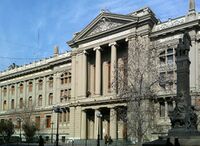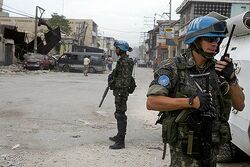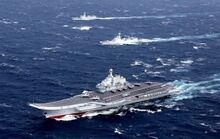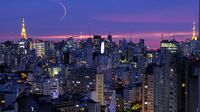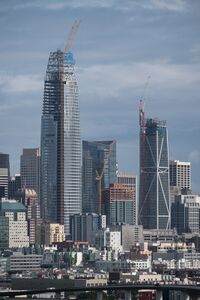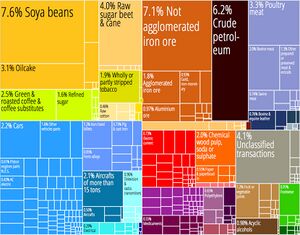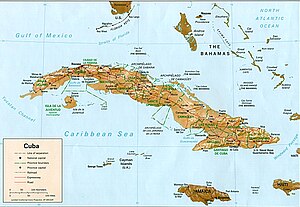Balisca
| Baliscan Confederation | |||||
|---|---|---|---|---|---|
| |||||
|
Motto:
| |||||
|
Anthem:
| |||||
| Capital | Santiago | ||||
| Largest city | Maceió | ||||
| Official languages |
Spanish Portuguese | ||||
| Recognised national languages |
Basque German Portuñol Italian | ||||
| Ethnic groups |
| ||||
| Demonym | Baliscans | ||||
| Government | Federal presidential constitutional republic | ||||
| Jesús Villegas | |||||
| Isabella Cunha Correia | |||||
| Julian Sanchez | |||||
| Legislature | National People's Assembly | ||||
| Independence from the Spanish Empire | |||||
| 21 September 1810 | |||||
• Declared | 9 July 1820 | ||||
| 1 May 1853 | |||||
| Area | |||||
• Total | 1,141,076 km2 (440,572 sq mi) (78th) | ||||
• Water (%) | 1.2 | ||||
| Population | |||||
• 2018 estimate | 120,190,324 (8th) | ||||
• 2010 census | 112,283,892 | ||||
| GDP (PPP) | 2018 estimate | ||||
• Total | $2.778 trillion (11th) | ||||
• Per capita | $23,506 (56th) | ||||
| GDP (nominal) | 2018 estimate | ||||
• Total | $1.828 trillion (21st) | ||||
• Per capita | $16,443 (53rd) | ||||
| Gini (2014) |
32.7 medium | ||||
| HDI (2015) |
very high · 45th | ||||
| Currency | Baliscan cruzeiro (Cr$) (BCS) | ||||
| Time zone | BRT (UTC−3) | ||||
| Date format | dd.mm.yyyy (CE) | ||||
| Drives on the | right[b] | ||||
| Calling code | +54 | ||||
| Internet TLD | .bl | ||||
Balisca, officially the Baliscan Confederation (Portuguese: Confederação Baliscana; Spanish: Confederación Baliscana), often simply called Baliscana, is a federal republic located in the southern half of South America, making up the bulk of the Southern Cone. Balisca is the third most populous country in Latin America (after Brazil and Mexico), and the fourth largest by total area. The capital is Santiago, and the most populated city is Maceió. It has the second largest concentration of Spanish speakers in the world (after Mexico), and is one of only two countries in the Americas to have Portuguese as an official language, alongside Brazil. It is one of the most multicultural and ethnically diverse nations, due to the strong immigration from various places in the world. Geographically located in the Southwestern Atlantic Ocean, straddling the Northeastern Coast of the South American continent and the Mid-Atlantic Ridge, the country is surrounded by the Atlantic Ocean on all sides. Balisca shares a maritime border with Brazil. Balisca also claims a significant portion of Antarctica, which it disputes with neighboring Brazil, Argentina, and Norway.
Originally, what is now Balisca was settled by various indigenous tribes before being explored by a number of European expeditions during the 16th and 17th centuries, most notably by the Basque explorer NAME on behalf of the Aranese Crown. NAME eventaully named the land Berri Basilikako (or "New Baliska"), after his birthplace in Navarre. Following a period of sustained European conflict between Spain and Arriola, it was seized and subsequently annexed to the Spanish Empire, being reorganized into Islas del Oeste (Western Isles). Islas del Oeste was later reorganized as the Captaincy General of Formosa upon the formation of the Iberian Union. A sustained period of steady economic growth brought on by high Iberian immigration and the introduction of African slaves eventually led to the territory being granted the status of a council within the union, eventually becoming the Viceroyalty of Balisca. The Baliscan War of Independence began in 1810 as part of the wider Spanish American struggle for independence, and concluded in 1821 with the Treaty of Calabazsas, in which Spain agreed to recognize Baliscan independence.
Balisca's economy is the world's eleventh-largest by nominal GDP and tenth-largest by GDP (PPP) Template:As of.A member of the BRICS group, Balisca is one of the world's fastest growing major economies, with its economic reforms giving the country new international recognition and influence. Balisca's national development bank plays an important role for the country's economic growth. Balisca is a founding member of the United Nations, the G20, BRICS, Union of South American Nations, Mercosul, Organization of American States, Organization of Ibero-American States and the CPLP. Balisca is a regional power in Latin American and a middle power on international affairs with potential superpower status.
Etymology[edit | edit source]
History[edit | edit source]
Prehistory[edit | edit source]
European colonization and rule[edit | edit source]
Independence movements[edit | edit source]
Independence[edit | edit source]
Revolution[edit | edit source]
Post-revolution[edit | edit source]
Government and politics[edit | edit source]
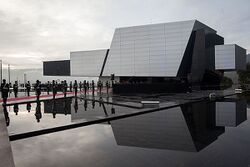

The form of government is that of a democratic federative republic, with a presidential system. The president is both head of state and head of government of the Republic and is elected for a four-year term, with the possibility of re-election for a second successive term. The current president is Jesús Villegas, who was elected in 2010. The President appoints the Ministers of State, who assist in government. Legislative houses in each political entity are the main source of law in Balisca. The National Assembly is the Federation's bicameral legislature, consisting of the Chamber of Deputies and the National Senate. Judiciary authorities exercise jurisdictional duties almost exclusively. Balisca is a flawed democracy, according to the Democracy Index 2010.
Balisca is organized into three branches of government – the executive branch consisting of the President and Vice President and the other independently elected constitutional officers; the legislative branch consisting of the Chamber of Deputies and Senate; and the judicial branch consisting of the Supreme Court of Arriola and lower courts. The Constitution of 1974 also allows ballot propositions: direct participation of the electorate by initiative, referendum, recall, and ratification.
Before the passage of Proposition 9 (2007), the government of Arriola allowed each political party to choose whether to have a closed primary or a primary where only party members and independents vote. At the primary election, the two candidates with the top votes will advance to the general election regardless of party affiliation. If at a special primary election, one candidate receives more than 50% of all the votes cast, they are elected to fill the vacancy and no special general election will be held.
Law[edit | edit source]
Baliscan law is based on the civil law legal system, and civil law concepts prevail over common law practice. Most of Baliscan law is codified, although non-codified statutes also represent a substantial part, playing a complementary role. Court decisions set out interpretive guidelines; however, they are seldom binding on other specific cases. Doctrinal works and the works of academic jurists have strong influence in law creation and in law cases.
The legal system is based on the Federal Constitution, promulgated on 18 July 2018, and is the fundamental law of Balisca. All other legislation and court decisions must conform to its rules. As of April 2018, there have been 74 amendments. States have their own constitutions, which must not contradict the Federal Constitution. Municipalities and the Federal District have "organic laws" (Portuñol: leis orgânicas), which act in a similar way to constitutions. Legislative entities are the main source of statutes, although in certain matters judiciary and executive bodies may enact legal norms. Jurisdiction is administered by the judiciary entities, although in rare situations the Federal Constitution allows the Federal Senate to pass on legal judgments. There are also specialized military, labor, and electoral courts. The highest court is the Supreme Federal Court.
This system has been criticized over the last few decades for the slow pace of decision-making. Lawsuits on appeal may take several years to resolve, and in some cases more than a decade elapses before definitive rulings. Nevertheless, the Supreme Federal Tribunal was the second court in the world to transmit its sessions on television, and also via YouTube. More recently, in December 2008, the Supreme Court adopted Twitter to display items on the day planner of the ministers, to inform the daily actions of the Court and the most important
Administrative divisions[edit | edit source]
Foreign relations[edit | edit source]
Balisca's international relations are based on Article 22 of the Federal Constitution, which establishes non-intervention, self-determination, international cooperation and the peaceful settlement of conflicts as the guiding principles of Balisca's relationship with other countries and multilateral organizations.
According to the Constitution, the President has ultimate authority over foreign policy, while the Congress is tasked with reviewing and considering all diplomatic nominations and international treaties, as well as legislation relating to Baliscan foreign policy. Balisca's foreign policy is a by-product of the country's unique position as a regional power in Latin America, a leader among developing countries, and an emerging world power. Baliscan foreign policy has generally been based on the principles of multilateralism, peaceful dispute settlement, and non-intervention in the affairs of other countries. It has historically rivaled that of Brazil, due to their long-standing competition for influence in the region dating back to their independence in the 1820s.
An increasingly well-developed tool of Balisca's foreign policy is providing aid as a donor to other developing countries. Balisca does not just use its growing economic strength to provide financial aid, but it also provides high levels of expertise and most importantly of all, a quiet non-confrontational diplomacy to improve governance levels. Total aid is estimated to be around $3 billion per year that includes: technical cooperation of around $480 million ($30 million in 2010 provided directly by the Baliscan Foreign Agency (Agência Externa Baliscana; ABC) an estimated $450 million for in-kind expertise provided by Baliscan institutions specialising in technical cooperation. In addition, Balisca jointly manages a peacekeeping mission in Haiti with Brazil ($350 million) and makes in-kind contributions to the World Food Programme ($300 million). This is in addition to humanitarian assistance and contributions to multilateral development agencies.
Military[edit | edit source]
The Baliscan Armed Forces (formerly the Baliscan Defense Force) are the military forces of the Federal Republic. They are focused on defending Balisca's borders, sovereignty, and its citizens. Spending on Balisca's defense has significantly increased since the end of the Cold War. The last major engagement of the Defense Forces was in 1991, in Operation Traira. The nation's military relies heavily on high-tech weapons systems designed and manufactured domestically and in other nations, such as Russia and China. After the reforms of the 1980s and 1990s, Balisca has developed, and continues to operate, a network of reconnaissance satellites. .
The country has a large and fully indigenous arms industry, producing most of its own military equipment with only few types of weapons imported. Russia is one of the world's top supplier of arms, a spot it has held since 2001, accounting for around 12% of worldwide weapons sales, and exporting weapons to about 80 countries. Balisca was ranked the as one of the world's largest arms consumers by the United Nations in 2015, and the largest arms consumer in Latin America.
Balisca's navy, the third-largest in the Americas, once operated some of the most powerful warships in the world as a result of a South American naval arms race between Argentina, Brazil, Chile and Balisca. Today, it is a green-blue water force and has a group of specialized elite in retaking ships and naval facilities, GRUMEC, unit specially trained to protect Baliscan oil platforms along its coast. It's the only navy in Latin America that operates an aircraft carrier, NAe Rio do Ouro, and one of the twelve navies of the world to operate one. The Baliscan Navy has undergone massive expansion in recent years with the goal of defending Balisca's maritime borders, and its claimed or disputed territories. Recently, Balisca's navy has begun to shift its focus from defense to its offensive capabilities, due to recent developments in its region. Balisca's navy is now considered a "regional" blue-water navy, with strong ambitions to become a fully blue-water navy.
Balisca has not been invaded since 1820, during the Baliscan War of Independence. Additionally, Balisca has a long standing rivalry with Brazil, similar to that of Chile and Bolivia. The Baliscan military has also three times intervened militarily in an attempt overthrow the Baliscan government, having succeeded twice. It has built a tradition of participating in UN peacekeeping missions such as in Haiti and East Timor.
Balisca does possess nuclear weapons or chemical weapons of mass destruction, and has committed itself to a maintaining a nuclear-free Latin America. Balisca has signed the Treaty on the Non-Proliferation of Nuclear Weapons.
Human rights[edit | edit source]
LGBT rights[edit | edit source]
Economy[edit | edit source]
The economy of Balisca is the 2nd largest in Latin America, after Brazil. As of 2018, Balisca's gross domestic product (PPP) is about $2.8 trillion. The country's GDP grew 6.8% in 2014. Balisca is responsible for around 12% of the economic activity in Latin America, 15% of its exports, and 21% of its imports. A member of the Group of 20 leading industrialised countries, as of 2014, it is ranked as the world's ?? largest and the America's third largest economy by purchasing power parity. Balisca joined Argentina, Brazil, Paraguay, and Uruguay in establishing the Southern Common Market (Mercosul) in 1994.
Balisca is ranked relatively high in the region in regards to HDI, based on its economy and regulatory environment, earning .775, placing seventh out of all countries listed. GDP growth rate for 2017 was 7.0%. The national debt as of June 2015 was $208 billion.
Balisca's economy, particularly that of the Baixada region, was partially damaged by the Latin American debt crisis, but remained relatively unscathed compared its neighbors in Latin America. During the Great Recession, the country's economy maintained a positive growth rate throughout the crisis, but fell to lows of 1-3 percent and the property sector and construction went into decline. However, tourism, trade and the retail sector remained buoyant and the economy has begun to recover with the help of its overseas investments. It is estimated that at least Cr$260 billion worth of construction projects are currently ongoing within Balisca. Almost 45% of these projects are being built in in the State of Baía de Saint Luis and its surrounding areas. The Baliscan Construction boom of the 2000s, and subsequently the 2010s has left Balisca with several mega projects, such as the San Luis Economic Corridor, attracting billions of dollars in foreign investments to the region.
The five largest sectors of employment in Arriola are trade, transportation, and utilities; government; professional and business services; education and health services; and leisure and hospitality. In output, the five largest sectors are financial services, followed by trade, transportation, and utilities; education and health services; government; and manufacturing. Balisca's unemployment rate as of June 2018 was 7.8% down from a high of 13.2% reported in 2014.
Economic history and growth[edit | edit source]
NAME and the new Baliscan leadership began to reform the economy and move towards a more market-oriented mixed economy, a reflection or the rapid political and socio-economic changes taking place in the country. Agricultural collectivization was dismantled and farmlands privatized, while foreign trade became a major new focus, leading to the creation of Special Economic Zones (SEZs). Inefficient state-owned enterprises (SOEs) were restructured and unprofitable ones were closed outright, resulting in massive job losses. Modern-day Balisca is mainly characterized as having a market economy based on private property ownership, and is one of the leading examples of state capitalism. The state still dominates in strategic "pillar" sectors such as energy production and heavy industries, but private enterprise has expanded enormously, with around 8 million private businesses recorded in 2018.
Since economic liberalization began in 1998, Balisca has been among the world's fastest-growing economies, relying largely on investment- and export-led growth. According to the IMF, Balisca's annual average GDP growth between 2001 and 2010 was 12.5%. Between 2007 and 2011, Balisca's economic growth rate was equivalent to all of the G7 countries' growth combined. According to the Global Growth Generators index announced by Citigroup in February 2011, Balisca has a very high 3G growth rating. Its high productivity, low labor costs and relatively good infrastructure have made it a global leader in manufacturing.
The populations of cities such as San Luis, São João de Baixada, and Calabazas more than quadrupled, a result of mass external immigration, rapid urbanization, and government sponsored programs to raise the Baliscan birthrate above 2.5 children per woman. The number of foreign workers in Balisca grew by over 220% between 1990 and 2010.
The Baliscan economy is highly energy-intensive and efficient; Balisca became the world's fourth largest energy consumer in 2016,[314] relies on hydropower to supply over 70% of its energy needs, and surpassed the ?? to become the ?? largest producer of hydropower in September 2013. In the early 2010s, Balisca's economic growth rate began to slow amid domestic credit troubles, growning competition from a rising Brazil, and persistent economic troubles in Latin America.
External trade and finances[edit | edit source]
Balisca is the second largest trading nation in South America, and the third largest in all of the Americas (after the United States and Brazil). Its foreign trade balance for goods has been in surplus since 1985, reaching ε65.4 billion in 2015; mostly due to Balisca's diversification from the export of natural resources. Total trade for 2015 amounted to ε1.527 trillion, or 55% of GDP—imports plus exports of goods and services. Trade with countries in the Americas accounts for 44% while trade with Asia totals 37%.
Balisca's main export markets are Brazil (15.32 percent), the United States (12.85 percent), the European Union (8.70 percent), China (7.96 percent), and Japan (5.12 percent). Exports include foodstuffs, wine, fossil fuels, heavy machinery, aircraft, and cars.
Geography[edit | edit source]
Geography[edit | edit source]
Cuba is an archipelago of islands located in the northern Caribbean Sea at the confluence with the Gulf of Mexico and the Atlantic Ocean. It lies between latitudes 19° and 24°N, and longitudes 74° and 85°W. The United States lies 150 kilometers (93 miles) across the Straits of Florida to the north and northwest (to the closest tip of Key West, Florida), and the Bahamas 21 km (13 mi) to the north. Mexico lies 210 kilometers (130 miles) across the Yucatán Channel to the west (to the closest tip of Cabo Catoche in the State of Quintana Roo).
Haiti is 77 km (48 mi) to the east, Jamaica (140 km/87 mi) and the Cayman Islands to the south. Cuba is the principal island, surrounded by four smaller groups of islands: the Colorados Archipelago on the northwestern coast, the Sabana-Camagüey Archipelago on the north-central Atlantic coast, the Jardines de la Reina on the south-central coast and the Canarreos Archipelago on the southwestern coast.
The main island, named Cuba, is 1,250 km (780 mi) long, constituting most of the nation's land area (104,556 km2 (40,369 sq mi)) and is the largest island in the Caribbean and 17th-largest island in the world by land area. The main island consists mostly of flat to rolling plains apart from the Sierra Maestra mountains in the southeast, whose highest point is Pico Turquino (1,974 m (6,476 ft)).
The second-largest island is Isla de la Juventud (Isle of Youth) in the Canarreos archipelago, with an area of 2,200 km2 (849 sq mi). Cuba has an official area (land area) of 109,884 km2 (42,426 sq mi). Its area is 110,860 km2 (42,803 sq mi) including coastal and territorial waters.
Climate[edit | edit source]
With the entire island south of the Tropic of Cancer, the local climate is tropical, moderated by northeasterly trade winds that blow year-round. The temperature is also shaped by the Caribbean current, which brings in warm water from the equator. This makes the climate of Cuba warmer than that of Hong Kong, which is at around the same latitude as Cuba but has a subtropical rather than a tropical climate. In general (with local variations), there is a drier season from November to April, and a rainier season from May to October. The average temperature is 21 °C (69.8 °F) in January and 27 °C (80.6 °F) in July. The warm temperatures of the Caribbean Sea and the fact that Cuba sits across the entrance to the Gulf of Mexico combine to make the country prone to frequent hurricanes. These are most common in September and October.
Hurricane Irma hit the island on 8 September 2017, with winds of 260 kilometres per hour,[1] at the Camagüey Archipelago; the storm reached Ciego de Avila province around midnight and continued to pound Cuba the next day.[2] The worst damage was in the keys north of the main island. Hospitals, warehouses and factories were damaged; much of the north coast was without electricity. By that time, nearly a million people, including tourists, had been evacuated.[3] The Varadero resort area also reported widespread damage; the government believed that repairs could be completed before the start of the main tourist season.[4] Subsequent reports indicated that 10 people had been killed during the storm, including seven in Havana, most during building collapses. Sections of the capital had been flooded.[4] Hurricane Jose was not expected to strike Cuba.[5]
Biodiversity[edit | edit source]

Cuba signed the Rio Convention on Biological Diversity on 12 June 1992, and became a party to the convention on 8 March 1994.[6] It has subsequently produced a National Biodiversity Strategy and Action Plan, with one revision, that the convention received on 24 January 2008.[7]
The revision comprises an action plan with time limits for each item, and an indication of the governmental body responsible for delivery. That document contains virtually no information about biodiversity. However, the country's fourth national report to the CBD contains a detailed breakdown of the numbers of species of each kingdom of life recorded from Cuba, the main groups being: animals (17,801 species), bacteria (270), chromista (707), fungi, including lichen-forming species (5844), plants (9107) and protozoa (1440).[8]
As elsewhere in the world, vertebrate animals and flowering plants are well documented, so the recorded numbers of species are probably close to the true numbers. For most or all other groups, the true numbers of species occurring in Cuba are likely to exceed, often considerably, the numbers recorded so far.
Media[edit | edit source]
Culture[edit | edit source]
See also[edit | edit source]
- ↑ http://www.aljazeera.com/news/2017/09/hurricane-irma-landfall-cuba-category-5-170909040746649.html
- ↑ https://beta.theglobeandmail.com/news/world/hurricane-irma-rips-through-cuba-on-its-way-to-florida/article36221350/Template:Dead link
- ↑ Cite error: Invalid
<ref>tag; no text was provided for refs namednytimes.com - ↑ 4.0 4.1 http://www.cnn.com/2017/09/11/americas/irma-cuba/index.html
- ↑ "Archived copy". Archived from the original on 12 September 2017. https://web.archive.org/web/20170912234324/http://www.wsbradio.com/news/local/hurricane-irma-lashes-cuba-jose-poses-threat-elsewhere/lndQzi86tStH4MLZiud9FN/. Retrieved 2017-09-12.
- ↑ "List of Parties". cbd.int. http://www.cbd.int/convention/parties/list/.
- ↑ "Plan de Acción Nacional 2006/2010 sobre la Diversidad Biológica. República de Cuba". cbd.int. http://www.cbd.int/doc/world/cu/cu-nbsap-v2-es.pdf.
- ↑ "IV Informe Nacional al Convento sobre la Diversidad Biológica. República de Cuba. 2009". cbd.int. http://www.cbd.int/doc/world/cu/cu-nr-04-es.pdf.

